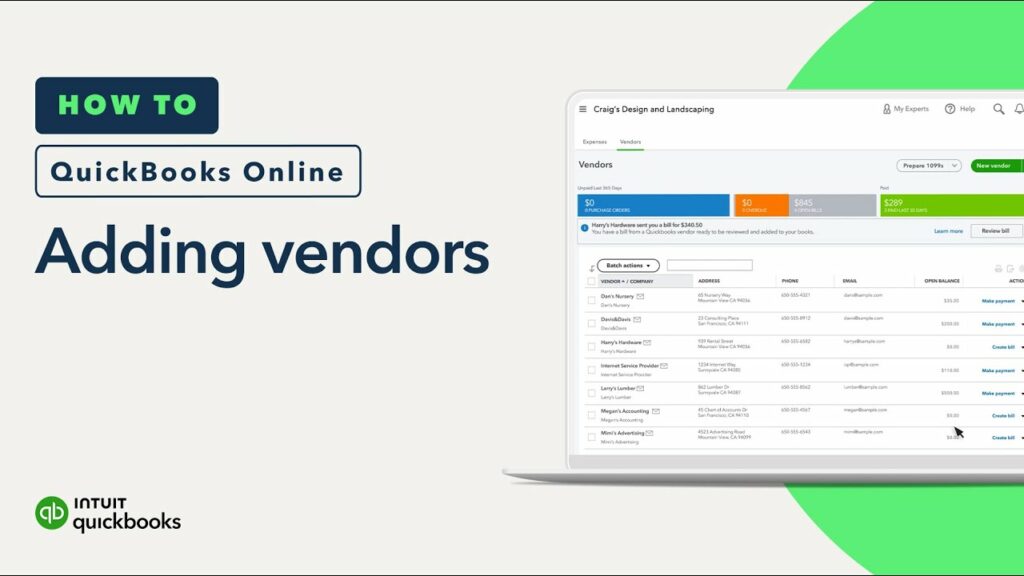Mastering Vendor Management in QuickBooks: A Comprehensive Guide

Understanding the Importance of Vendor Management
Efficient vendor management is a cornerstone of successful business operations. It ensures timely payments, accurate record-keeping, and fosters strong supplier relationships. QuickBooks provides a robust platform to streamline these processes.
Creating and Managing Vendor Records
The first step in effective vendor management is establishing accurate and complete vendor records.
QuickBooks Online
- Navigate to the Expenses tab.
- Select “Vendors.”
- Click “New Vendor.”
- Enter vendor details: Name, address, contact information, payment terms, tax information, and other relevant data.
- Save the vendor record.
QuickBooks Desktop
- Go to the Lists menu.
- Select “Chart of Accounts.”
- Create a vendor account: Choose the appropriate account type (accounts payable, credit card, etc.).
- Enter vendor details: Name, address, contact information, payment terms, tax information, and other relevant data.
- Save the vendor record.
Categorizing Vendors
For efficient management, categorize vendors based on various criteria:
- Type of service or product: This helps in tracking expenses and identifying potential cost-saving opportunities.
- Payment terms: Categorizing vendors by payment terms ensures timely payments and avoids late fees.
- Tax status: Proper categorization based on tax status is essential for accurate tax reporting.
- Preferred payment method: Understanding preferred payment methods helps in streamlining payment processes.
Entering and Paying Bills
QuickBooks simplifies the bill payment process.
QuickBooks Online
- Go to the Expenses tab.
- Select “Bills.”
- Click “New Bill.”
- Enter bill details: Vendor, date, amount, due date, and other relevant information.
- Classify expenses: Assign the bill to appropriate expense accounts.
- Save the bill.
- Pay the bill: Use online payments, checks, or credit cards.
QuickBooks Desktop
- Go to the Vendors menu.
- Select “Enter Bills.”
- Follow similar steps as in QuickBooks Online.
Tracking Vendor Performance
Effective vendor management involves assessing vendor performance.
- On-time delivery: Track delivery dates to identify reliable vendors.
- Product or service quality: Monitor product or service quality to ensure customer satisfaction.
- Payment terms adherence: Evaluate vendor compliance with payment terms to manage cash flow.
- Cost analysis: Compare prices from different vendors to identify cost-saving opportunities.
Utilizing QuickBooks Reports
QuickBooks offers various reports to analyze vendor performance and financial health.
- Vendor Balance Report: Shows outstanding balances for each vendor.
- Aging Summary Report: Categorizes vendor balances based on due dates.
- Vendor Performance Report: (Customizable) Tracks key performance indicators for vendors.
Advanced Vendor Management Techniques
For complex vendor management needs, consider these strategies:
- Vendor Relationship Management (VRM) Software: Integrate VRM software with QuickBooks for enhanced vendor communication and collaboration.
- Purchase Orders: Create purchase orders to formalize agreements with vendors and track order status.
- Expense Reports: Use expense reports to track vendor-related expenses and reimbursements.
- Vendor Discounts: Negotiate discounts with vendors and track savings.
- Vendor Audits: Conduct regular vendor audits to ensure compliance and identify potential issues.
Best Practices for Vendor Management
- Maintain accurate vendor records: Keep vendor information up-to-date.
- Establish clear communication channels: Foster open communication with vendors.
- Resolve disputes promptly: Address issues with vendors efficiently.
- Leverage technology: Utilize QuickBooks and other tools to streamline processes.
- Review vendor performance regularly: Evaluate vendor performance to make informed decisions.
By following these guidelines and leveraging QuickBooks’ capabilities, you can optimize your vendor management processes, improve cash flow, and build strong supplier relationships.




